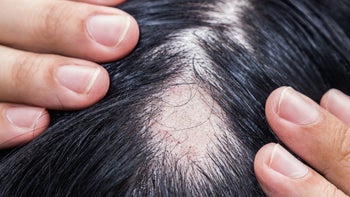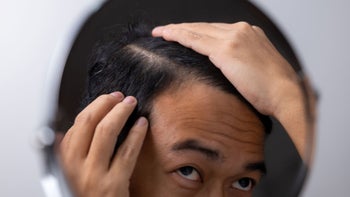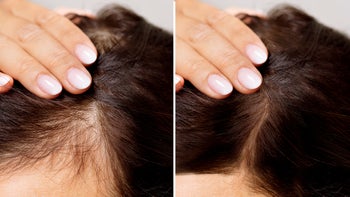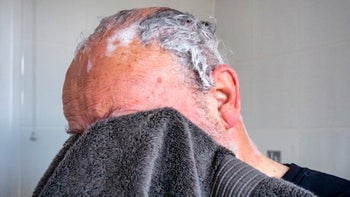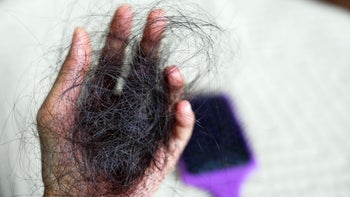
The Best Hair Loss Treatments for Women, Backed by Science
Key takeaways:
Hair loss in women has many causes, and the most common is female pattern hair loss. This type of hair loss leads to thinning and shedding on the front and top of the scalp.
Hair loss treatments for women include both prescription and over-the-counter (OTC) options, like minoxidil (Rogaine), finasteride, and spironolactone. There are also more expensive options, like low-level laser therapy and platelet-rich plasma injections.
Medicare and health insurance may offer some coverage for hair loss treatments. But you can’t always use funds from a healthcare savings account (HSA) or flexible spending account (FSA) for hair loss treatment.
Table of contents
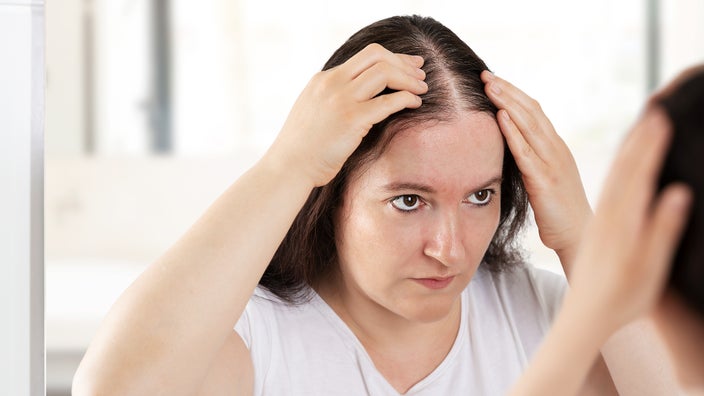
Though it may not get as much attention as male pattern baldness, hair loss in women is very common. There are different types, and the most common one is female pattern hair loss. This type causes hair thinning on the front and top of your scalp. But unlike male pattern baldness, it rarely causes complete baldness. It usually affects women in middle age, and up to half of all women may experience it in their lifetime.
There’s a dizzying array of possible treatment options for hair loss. But some are costly, and others don’t work — or may even cause more hair damage. Before deciding on a hair loss treatment, it’s best to talk to a healthcare professional. They can help determine if the cause is female pattern hair loss or something else and then create a treatment plan that’s right for you.
It’s also important to know that some hair loss treatments for women are considered “off-label.” This means the medication was approved by the FDA for a different condition, not female pattern hair loss. Still, these medications have been extensively researched. The American Academy of Dermatology and other experts consider them safe and effective for female pattern hair loss.
Search and compare options
Here’s a list of six science-backed treatment options for female pattern hair loss.
1. Minoxidil
Minoxidil (Rogaine) is an FDA-approved treatment for female pattern hair loss. It’s one of the most well-known treatment options for hair loss and has been around since 1991. For women, minoxidil is available over the counter (OTC) as a 2% solution or a 5% foam. It’s also available off-label as a pill. But oral minoxidil is usually saved for people who don’t respond to OTC options.
There’s a large body of evidence that shows minoxidil helps regrow hair. But it’s important to keep in mind that it can take months to see these effects. Experts recommend using it consistently for 1 year before deciding if it’s working or not.
Minoxidil 2% solution needs to be applied twice a day, while the 5% foam only needs to be applied once a day. You apply the medication directly to your scalp and massage it in with your fingers. Experts recommend applying the medication 2 hours before going to sleep so that it has enough time to dry.
Minoxidil causes very few side effects, which also makes it a popular option. The most common side effect is scalp irritation or redness. One thing to be aware of is that minoxidil causes hair shedding in the first few weeks of use. This is normal. It happens because the hair is moving from its resting phase into a new growth phase. This isn’t a sign that the medication isn’t working or making your hair loss worse.
2. Finasteride
Finasteride (Propecia) is FDA-approved to treat male pattern baldness. It helps minimize hair loss by blocking testosterone’s effect on hair. While it’s not approved for female pattern hair loss, it’s a first-line treatment for this condition. Finasteride is available as an oral medication.
What causes hair loss? Find out the most common causes of hair loss in women.
Do medications cause hair loss? Our experts explain which medications might lead to hair loss.
Many supplements on the market claim to treat hair loss. But do they work? Here’s what you need to know about vitamin deficiency and hair loss.
The typical dosage is between 2.5 mg and 5 mg each day. Most people see results in about 3 to 6 months.
People who are pregnant or may become pregnant shouldn’t take finasteride. Otherwise, people tend to experience very few side effects with the medication, making it a popular option.
Flutamide (Eulexin) also blocks testosterone, but in a different way. It’s not used as often as minoxidil or finasteride to treat female pattern baldness. But there’s some evidence that it helps improve hair growth. Flutamide can cause side effects like lower libido, stomach upset, and liver injury.
3. Spironolactone
Spironolactone (Aldactone) is FDA-approved to treat a number of medical conditions. These include heart failure, high blood pressure, leg swelling, and certain types of acne. There’s some evidence that it can help with hair growth by blocking hormones that contribute to hair loss. Studies show that spironolactone can help regrow hair when used alone or with other treatments like minoxidil or laser therapy.
Most people start this medication at a dose of 50 mg per day. Over time, the dose may gradually increase to 100 mg or 200 mg per day.
Spironolactone can cause many side effects. These may include headaches, decreased libido, menstrual irregularities, dizziness, and fatigue. It can also increase potassium levels in your blood. If you have heart or kidney problems or take medications that increase potassium, you may need to have your potassium level checked regularly.
You can’t take spironolactone if you’re pregnant or planning to become pregnant.
4. Ketoconazole shampoo
Ketoconazole shampoo is an antifungal medication. It’s available by prescription (2%) or OTC (1%). It works similarly to finasteride in terms of how it can help with hair loss.
It’s not FDA-approved for hair loss, but studies suggest it can help — especially when used in combination with other treatments.
Side effects of ketoconazole shampoo may include dryness, itching, and redness of the scalp.
5. Low-level laser therapy
Low-level laser therapy is a treatment designed to reverse hair thinning or hair loss. In some studies, people noticed increased hair density after 24 to 26 weeks. It worked better than topical minoxidil alone. Some research suggests it may work even better in combination with other treatments. It’s unclear exactly how laser therapy helps, but experts think it may be related to anti-inflammatory effects.
There are several FDA-approved laser devices available to make hair appear thicker and fuller. These devices come in many forms, including hairbands, caps, and combs. Right now, there’s no evidence that one brand works better than any other. And it may not work for everyone. It can also be very expensive, with devices ranging in price from $500 to $5,000. More studies are needed to see how well these treatments work over time.
6. Platelet-rich plasma (PRP)
Platelet-rich plasma (PRP) injections may help restore hair growth for female pattern hair loss. Platelets are blood cells that help form blood clots by releasing proteins called growth factors. There’s building evidence that growth factors can also stimulate hair follicles to regrow hair. While PRP looks promising as a hair loss treatment, experts say larger studies are needed to confirm reliable results.
PRP is done at a doctor’s office. Every few weeks, a small amount of your blood is drawn. That blood gets spun in a machine to remove the platelet cells. These platelets are then injected into your scalp. You may need treatments for 3 to 4 months, followed by regular “boosters” every 6 to 12 months. The procedure is time consuming and can be uncomfortable. Many people report post-injection headaches, scalp pain, redness, and swelling.
The cost of PRP can range from around $500 to $2,500 or more per treatment. Insurance usually doesn’t cover PRP for hair loss, so you’ll likely have to pay the full amounts. Also, the price doesn’t guarantee results.
What are other treatments for hair loss in women?
The American Academy of Dermatology lists several other treatment options for female pattern hair loss. If you’re interested in alternatives, you and your dermatologist may want to discuss some of the following:
Microneedling: This involves poking small needles into your skin. People usually need 3 to 6 sessions, 1 month apart. Microneedling can cost between $100 and $500 per treatment.
Hair growth vitamins: There’s conflicting evidence about the role vitamins play in hair growth. Supplementation with vitamin D or biotin may help, but only if you’re deficient in these vitamins. There’s not enough evidence to suggest that other vitamins or supplements work.
Scalp massage: This can help promote hair growth. You can also try certain essential oils, but it’s important to be aware of possible allergic reactions.
Wigs and concealers: Wigs and concealers cause no side effects and give immediate results. They’re available in synthetic and natural options.
Hair transplants: Hair transplants require a surgical procedure that moves healthy hair follicles to areas with less hair growth. A dermatologist or plastic surgeon can perform a hair transplant. But the procedure can be quite expensive, costing between $3,000 and $20,000.
What causes female pattern hair loss?
It’s not exactly clear why some people develop female pattern hair loss, but there are a few possible explanations. Research shows that as people get older and go through menopause, hair spends less time in any growth phase. This causes hair to thin. Hair follicles also become thinner, which means the hairs themselves become thinner and don’t cover your head as densely.
Genetics may also play a role in female pattern hair loss. You may be more likely to get it if others in your family have it. But researchers haven’t found an exact genetic cause for female pattern hair loss.
Is treatment for hair loss covered by insurance?
Hair loss medications prescribed by a healthcare professional may or may not be covered by your insurance. But FDA-approved medications and treatments are more likely to be covered.
You’re also more likely to get coverage if you have another condition that’s causing hair loss along with female pattern baldness. For example, your hair loss may be caused by alopecia areata, an autoimmune condition. In this case, your health plan would likely cover some female pattern hair loss treatments as part of your overall care plan.
Is hair loss treatment for women covered by Medicare?
Medicare considers hair loss a cosmetic problem and won’t generally cover medications or other treatments for it. But if you have an underlying health condition causing hair loss, your insurance may cover treatments as part of your care.
Can I use my HSA or FSA account for hair loss treatments?
There are limited options to use funds from your flexible spending account (FSA) or health savings account (HSA) to pay for hair loss treatments. You can’t use these funds for anything used to promote hair regrowth, since this is considered a cosmetic treatment rather than a qualified medical expense.
If you have a separate medical condition causing hair loss, you may be able to use HSA or FSA funds for treatment. For example, if your hair loss is related to a vitamin deficiency, you may be able to use HSA or FSA funds to cover supplements. You’ll also need to get a letter of medical necessity from your healthcare team that says vitamins are necessary for treatment.
Similarly, if you lose your hair after chemotherapy or because of another disease or treatment, you may be able to buy a wig using FSA and HSA funds, as long as you have a letter of medical necessity.
The bottom line
If you have female pattern hair loss, there are treatment options available. It’s best to start by talking with a dermatologist or other healthcare professional to understand the cause. Some treatment options, like OTC minoxidil, may fit your budget, while others are more costly. You can work together with your healthcare team to find an effective treatment plan and discuss the cost of each option, including what your insurance might cover.
Why trust our experts?



References
Almohanna, H. M., et al. (2018). The role of vitamins and minerals in hair loss: A review. Dermatology and Therapy.
American Academy of Dermatology Association. (2022). Hair loss: Diagnosis and treatment.
American Academy of Dermatology Association. (2022). Thinning hair and hair loss: Could it be female pattern hair loss?
Blume-Peytavi, U., et al. (2011). A randomized, single-blind trial of 5% minoxidil foam once daily versus 2% minoxidil solution twice daily in the treatment of androgenetic alopecia in women. Journal of the American Academy of Dermatology.
Burns, L. J., et al. (2020). Spironolactone for treatment of female pattern hair loss. Journal of the American Academy of Dermatology.
de Oliveira, A. F. Q., et al. (2022). Use of autologous platelet-rich plasma in androgenetic alopecia in women: A systematic review and meta-analysis. Journal of Dermatological Treatment.
Fabbrocini, G., et al. (2018). Female pattern hair loss: A clinical, pathophysiologic, and therapeutic review. International Journal of Women’s Dermatology.
Fields, J. R., et al. (2019). Topical ketoconazole for the treatment of androgenetic alopecia: A systematic review. Dermatologic Therapy.
FSA Store. (n.d.). Hair regrowth or removal: FSA eligibility.
International Society of Hair Restoration Surgery. (n.d.). PRP for hair loss: Procedure, benefits & costs.
Jimenez, J. J., et al. (2014). Efficacy and safety of a low-level laser device in the treatment of male and female pattern hair loss: A multicenter, randomized, sham device-controlled, double-blind study. American Journal of Clinical Dermatology.
Johnson & Johnson. (2022). Women’s Rogaine Unscented- minoxidil aerosol, foam [package insert].
Johnson & Johnson. (2023). Women’s Rogaine Unscented- minoxidil solution [package insert].
Lanzafame, R. J., et al. (2014). The growth of human scalp hair in females using visible red light laser and LED sources. Lasers in Surgery and Medicine.
Messenger, A. G., et al. (2006). Follicular miniaturization in female pattern hair loss: Clinicopathological correlations. British Journal of Dermatology.
Paradisi, R., et al. (2011). Prospective cohort study on the effects and tolerability of flutamide in patients with female pattern hair loss. Annals of Pharmacotherapy.
Pillai, J. K., et al. (2021). Role of low-level light therapy (LLLT) in androgenetic alopecia. Journal of Cutaneous and Aesthetic Surgery.
Sinawe, H., et al. (2023). Ketoconazole. StatPearls.
Sinclair, R., et al. (2005). Treatment of female pattern hair loss with oral antiandrogens. British Journal of Dermatology.
Suchonwanit, P., et al. (2018). Low-level laser therapy for the treatment of androgenetic alopecia in Thai men and women: A 24-week, randomized, double-blind, sham device-controlled trial. Lasers in Medical Science.
van Zuuren, E. J., et al. (2016). Interventions for female pattern hair loss. Cochrane Database of Systematic Reviews.
Yip, L., et al. (2009). Gene-wide association study between the aromatase gene (CYP19A1) and female pattern hair loss. British Journal of Dermatology.
Yip, L., et al. (2011). Role of genetics and sex steroid hormones in male androgenetic alopecia and female pattern hair loss: An update of what we now know. Australasian Journal of Dermatology.



